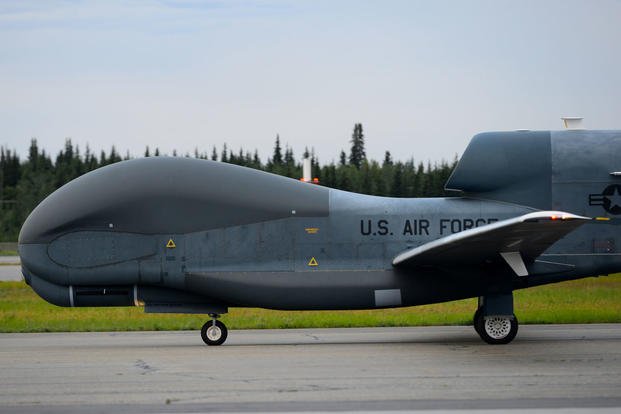A U.S. Air Force RQ-4 Global Hawk broke apart and crashed last year after the drone's navigation system caused it to fly at an altitude and speed it couldn't handle, according to a recent service investigation report.
The RQ-4, from the 9th Reconnaissance Wing at Beale Air Force Base, California, was conducting a flight from Edwards Air Force Base to Beale last June when one of the unmanned aerial vehicle's Litton inertial navigators produced "erroneous data" that told it to begin "a false left wing down roll," according to an accident investigation report published Wednesday.
A Northrop Grumman contractor aircrew was operating the drone from a mission control element, dubbed MCE1, a "portable shelter equipped to support enroute aircraft mission functions," out of Palmdale, California, while airmen monitored the event at MCE2 at Beale.
Prior to the flight, the Global Hawk experienced "problems with its links to [mission control elements] one and two," as well as high temperature warnings, the report said. Both issues were resolved and cleared before flight. It had earlier undergone right-wing maintenance at Edwards.
The RQ-4's Kearfott KN-4074E navigators (KNA and KNB) were turned off after takeoff, leaving its Litton LN-100G LNA/B navigators -- the drone's only other two navigators -- to steer the flight, the report said.
Related content:
- Northrop Tests New Global Hawk Drone Sensor
- Enlisted Drone Program Expands as Air Force Seeks More Operators
- MQ-9 Gets First Air-to-Air Kill in Training Exercise, Air Force Official Says
The drone took off before 12:30 p.m. local time. For about the first 50 minutes of the June 21 flight, the "mishap RPA ... turned to planned waypoints uneventfully." Then, the LNA navigation gave the false left-wing roll indication.
The Global Hawk, "having failed to detect the erroneous nature of LNA's navigational data, sent control inputs to correct the false roll data. This included keeping a full throttle, even while the [mishap RPA] was in an unusual nose low attitude," the report said. Roughly 20 seconds later, "the [mishap RPA] regained roll control but airspeed continued to increase."
The UAV subsequently lost its communication links with the mission control element hubs.
Shortly after losing link, "MCE1 and MCE2 received a data packet, showing the [mishap RPA] in an unusual attitude with increasing airspeed and maxed descent rate, before losing links again," the report said.
The data showed that the roll, combined with the acceleration, put the RQ-4 into a dive and caused structural damage.
The Global Hawk broke apart during flight and crashed in an unpopulated area near Lone Pine, California.
While the LNA navigator caused the crash, Col. Jeremy Thiel, the board's investigation authority, said that disabling the KNA/B navigators also contributed to the crash.
"I also find by a preponderance of evidence that disabling the [mishap RPA]'s two Kearfott KN-4074E navigators (KNA and KNB) after takeoff substantially contributed to the mishap," he said in his opinion summary.
The destroyed aircraft cost the Air Force $79 million.
-- Oriana Pawlyk can be reached at oriana.pawlyk@military.com. Follow her on Twitter at @Oriana0214.












